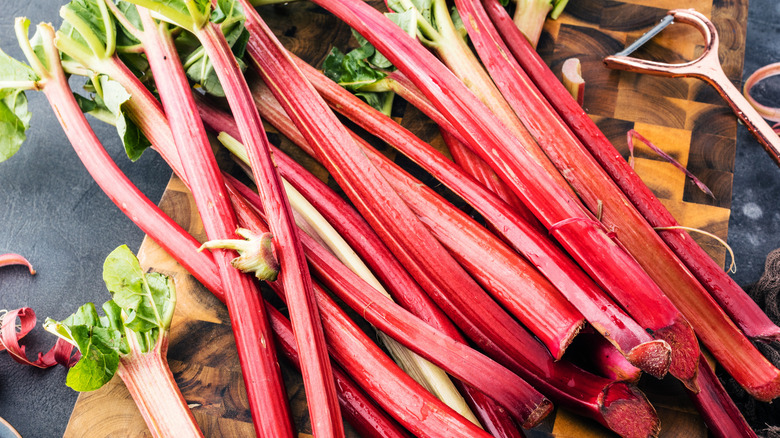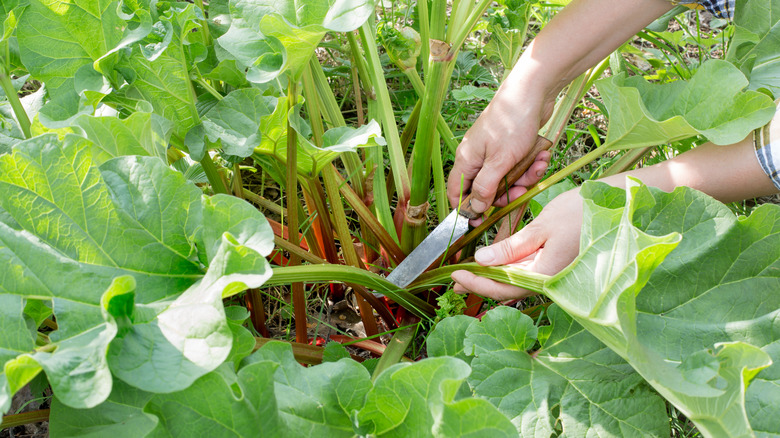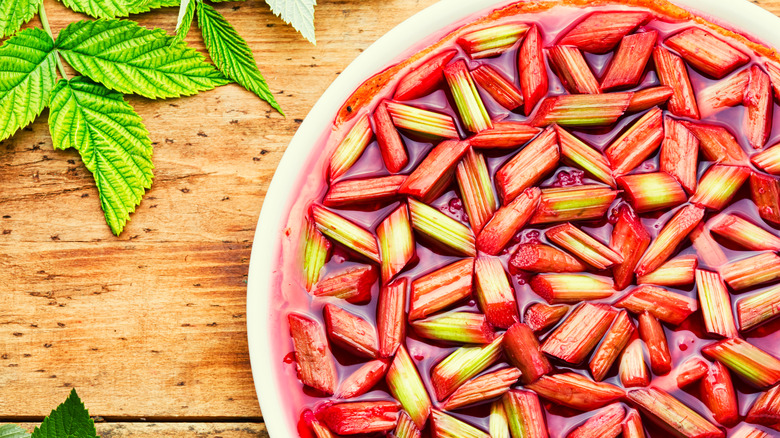When Is Rhubarb In Season?
Rhubarb, also known as Rheum rhabarbarum, per Candide, is a seasonal vegetable unfamiliar to many, making it a hidden gem in the farmer's market. It has broad red or green stalks commonly compared in shape and texture to celery. The ruby stalks are contrasted by huge green leaves, making rhubarb an attractive addition to a garden or yard. The leaves contain toxic levels of oxalic acid, though, and only the stalks are edible according to Almanac. A bite of the raw, crunchy stalk has an overwhelming sour flavor. However, after being cooked with the addition of sugar, perhaps most well-known in the form of strawberry-rhubarb pie, rhubarb transforms into a delightfully tart sweet treat.
Although technically a vegetable, rhubarb is so often used akin to fruit in dessert recipes that the United States classified it as a fruit in 1947 (via Taste of Home). If you aren't a fan of desserts, there are savory recipes that incorporate rhubarb as well, such as in salads or meat braises.
How to find rhubarb
According to Taste of Home, rhubarb thrives in temperatures below 75 degrees, so it is commonly found in northern states starting in April, making it an iconic sign of springtime. Often, it can be harvested through June, and sometimes into the summer, depending on the region's climate (via The Spruce Eats).
Starting in early spring, you can start to check for the crop at your local farmer's market or grocery store. The stalks you choose should be firm, shiny, and relatively unblemished. Although both the green and red stalks can be eaten, go for the red stalks on the thinner side for sweeter rhubarb, according to Bon Appétit. Flimsy or rubbery stalks can be a sign that the plant underwent frost damage and should be avoided, as the poisonous oxalic acid from the leaves may have spread to the stalks (via Taste of Home). If you are lucky enough to live in a cooler region, consider growing your own rhubarb. According to Almanac, it should be planted in a sunny spot with good drainage. It is a perennial plant, so you can reap the benefits for years to come.
Storage and preparation
Once you've secured a source of this special springtime plant, make sure to put it to good use. According to Taste of Home, rhubarb should be loosely wrapped in order to stay moist and kept in the fridge, where it will stay fresh for two weeks. It can also be cut up into recipe-ready pieces and frozen for up to a year, according to Taste of Home.
To prepare the rhubarb, discard any part of the plant other than the stalks, which should be washed and trimmed. Then, it's time to get creative! Consider pairing it with other spring produce, such as strawberries, which counteract the tartness of rhubarb with their sweetness. Rhubarb can easily be used to make sauces, pies, beverages, scones, or anywhere you'd enjoy a fresh and tart flavor profile. Although it is simplest to cook it with sugar in order to balance its sour taste, adventurous cooks can also experiment with pairing rhubarb with meats, sliced into salads, incorporated into chutneys, or other savory dishes. Since it is typically only available for a few months out of the year, be sure to grab some if you see it available at your local market.


